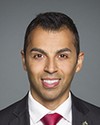Thank you very much, Mr. Chairperson. I'm very happy to be back before this committee.
I'll try to be brief, because I think it's more important that you hear directly from our colleagues, Somali refugees who have first-hand experience of what it means to live in Dadaab.
Let me just set the scene with a few numbers. I remind everyone that Kenya hosts the third-largest refugee population in Africa, with something close to half a million refugees, of whom 90% are in the Dadaab and Kakuma camps. The overwhelming majority, 300,000, are from Somalia.
Somalia has the world's fourth-largest refugee population, with approximately 900,000 Somali refugees in all parts of the world. Also, let's not forget the one million IDPs. It's a very protracted crisis. We are well into the third decade of this crisis; we need to find a solution to the plight of these almost one million refugees.
Dadaab, with the Government of Kenya and UNHCR, went through a verification process in the summer of 2016, and so we can give you quite precise numbers. Currently there are 280,000 refugees in Dadaab. The overwhelming majority are from Somalia. Out of this number, we were able to verify that 40,000 people were what we call “double registration”, people who either were in our database twice or actually were Kenyans with ID and therefore were living near or in the camps but were not actual refugees. Out of the 280,000 assessed in December 2016, 69,000 have expressed an interest in returning to Somalia.
As I always mention before this committee—because money is part of the equation, unfortunately—UNHCR Kenya has asked for $250 million for 2017, of which $173 million is specifically to respond to the Somali refugees. Out of the $250 million, 2%—I repeat, 2%—has been received, and when we try to go into the earmarking for the Somali refugees, 0% of the money has been received as we speak.
It's the same for HCR in Somalia, which is dealing with the protection of one million IDPs and support for returnees. We have asked for $85 million and have received only 6% of this funding. If you compare with other numbers floating around, vis-à-vis other crises that are monopolizing the attention, the money requested is not that high. The main donors are Sweden, the Netherlands, Norway, Denmark, Australia, and Switzerland. Canada has given us, for the east and the Horn of Africa, $19 million in 2016 and $14 million in 2017. That is not only for Kenya and Somalia but for the whole east and Horn of Africa, which is plagued by the famine. In addition, as you know, recently Minister Hussen released information that $21 million Canadian had been given to all partners to respond to the crises in Somalia, the drought, and the famine.
We are very grateful to the Government of Kenya for the co-operation we are getting from them and for the fact that they have kept the border open and are respecting the principle of non-refoulement. All the returns to Somalia are thus very much based on voluntary and informed decisions by the refugees who are in Dadaab currently.
As you mentioned, Mr. Chairperson, in November there was an announcement that the camp would be closed. The High Court of Kenya came in, intervening in February with a decision that is being appealed by the government. We are working very closely with the refugee affairs secretariat, which has been set up by the Government of Kenya to try to find a solution.
In this respect, I would just like to draw your attention to President Kenyatta's statement at the IGAD—the Intergovernmental Authority on Development—which in March of this year was looking at the situation of the closure of the camp and the support to Somalia. The statement from His Excellency the President of Kenya reiterates that the return to Somalia will be done in an orderly, safe, and dignified manner, respecting very much the principle of non-refoulement and the choice of the people.
We are pushing for three solutions vis-à-vis Dadaab, and that's where I think your committee may wish to make a recommendation to the Government of Canada in supporting those three solutions. First is supporting the voluntary and spontaneous return of those Somali refugees in Dadaab who have expressed the desire to return to Somalia. According to a tripartite agreement signed in 2013 between UNHCR, Somalia, and Kenya, we are supporting this. We are not encouraging in any way; it's a free choice for people to decide whether they want to go back to Somalia. I have just a few numbers. In 2014, 500 people opted for this option. In 2015, 5,000 people, and in 2016, 30,000 people decided to return to Somalia. We have an estimate that around 63,000 Somali refugees have returned to Somalia since December 2014 of their own free will, supported by UNHCR. The gender ratio, as I know this is an important question for this committee, is 50-50 men and women
Upon arrival in the 12 areas, which have been assessed as potential areas for return, we provide UNHCR education and health, but also very importantly, livelihood, shelter, and protection activities. Everybody—including those choosing not to return to those 12 areas—is still supported, including through cash support, anywhere they go in the country. We are organizing go-and-see visits for the refugees to go and see the situation on the ground, come back, and inform the community about what is possible for them to do upon return, what kind of services they will receive, and so on. We expect probably 50,000 to return this year, and potentially 65,000 in 2018.



